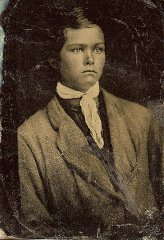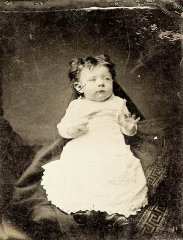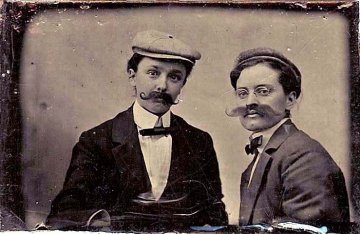I have been collecting tintypes for a number of years, and frequently ‘sample’ them in my own artwork. The ones I find myself most attracted to usually carry some hint of what Greil Marcus calls ‘the old weird America.’ Rather more than any other kind of antique photograph, the tintype communicates a sense–to me at least–of the utter strangeness, the alterity, of the past.
For those unfamiliar with this photographic method, I provide a short history, borrowed with many thanks from the anonymous (and expert) enthusiasts at City Gallery–a superbly informative website devoted to all kinds of vernacular photography.
‘Tintype images began life as an inexpensive alternative to the daguerreotype. In the two decades after the introduction of the daguerreotype in 1839, photographic experimenters had energetically sought a less expensive and cumbersome way of capturing the photographic image. The tintype was patented in 1854 and later sold to Neff in 1856.
’Very similar in appearance to their Ambrotype cousins the tintype has a pale whitish image. Both the ambrotype and tintype are”collodion” images. In the ambrotype process, a small plate of glass is made light sensitive by pouring a mixture of collodion (gun cotton and silver nitrate) over one surface. The tintype process is exactly the same except that a small iron plate is sub- stituted for the glass. Unlike the ambrotype, the plate was usually exposed in a “multiplying” camera capable of exposing a number of small images at once onto a single plate. Each duplicate image could then be cut from the whole plate and distributed to friends or family.
‘The main advantages of the tintype were threefold: it created an unbreakable, durable, photographic image supported on an iron plate, which could be carried into hazardous conditions such as battle without breaking like the fragile daguerreotype; it was the first truly instant photograph, ready for the sitter in a few minutes; it was inexpensive, its lowered cost of production meant working class could own photographs. Indeed, the tintype remained popular at seaside resorts and county fairs well into the 20th century exactly because it was the only instant photograph available. Later, its function was replaced by instant photo booths and the Polaroid cameras in the 1950s. The tintype had one of the longest periods of popularity of any early photograph type, lasting from the mid 1850s to the 1930s mostly at county fairs.
‘From 1875 to 1930 itinerant photographers continued the tintype business on into the twentieth century in what is known as the carnival period. These itinerant tintypists set up studio tents at public gatherings, such as fairs and carnivals. They came equipped with painted backdrops of Niagara Falls, beach, boat and other novelty props for comic portraits. Other tintype galleries operated on the popular boardwalks at beach resorts. Early tintypes were placed in the leather or plastic (thermomolded) cases used for ambrotypes. Some tintypes may be seen loose in their gilt frames (image packet) either to reduce cost or taken from cases. As the tintype customer demanded lower prices, the cases were dropped in favor paper folders the same size as the popular card photo- graphs (carte de visite) because the case cost more than the finished photograph. Some were decorated with patriotic themes like Potter’s Patent paper envelopes. Instead of a glass cover, the tintype image was given a quick coat of Japan Black lacquer (varnish) to protect the image and any applied tints. Tintype Cartes de Visite were a popular and inexpensive alternative to the carte de visite image. They mounted a regular tintype sandwiched in a stiff card mount with a window cut in the front for viewing the image.
‘Tintypes were lighter and less costly to manufacture than daguerreotypes or ambrotypes. The average price from the inception of the process in 1856 until its fade¬out was 10 cents to 25 cents for an image about the size of a playing card. Sometimes referred to as “The penny picture that elected a president”. the tintype sold for a penny or less, making photography universally available. Photography became a possibility for the isolated farmer as itinerant photographers spread out over the countryside. And in big cities working class people could afford a tintype image. Tintypes are measured in fractions of a full plate as are daguerre- otypes and ambrotypes. They came in full-plate, half-plate, quarter-plate, and one- sixth plate sizes. Tintypes frequently carelessly trimmed when separating the individual images from the whole plate. This is partly because the case or envelope would cover the edges of the image. Very often the tintype image was tinted, giving it a more lifelike quality than the monochrome image could offer. Tints were added to cheeks, lips, jewelry and buttons. People were not ready to accept a photograph for what it was, but wanted it to imitate painting. Many miniature painters left their dying trade to become colorists. It was easier to apply tints to a tintype than daguerreotype because of the difficulty of applying pigments. Some painted tintypes are elaborate examples of the decorative arts.’



